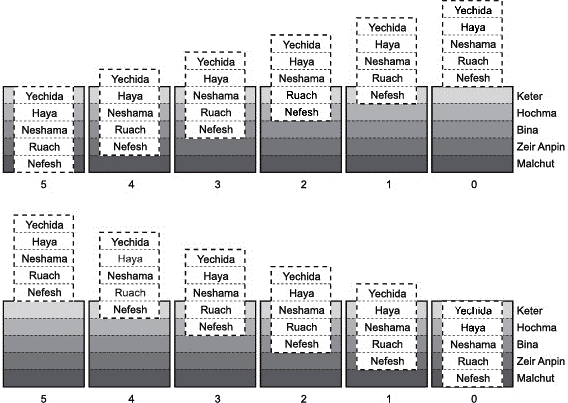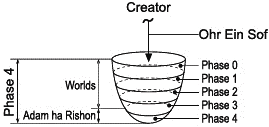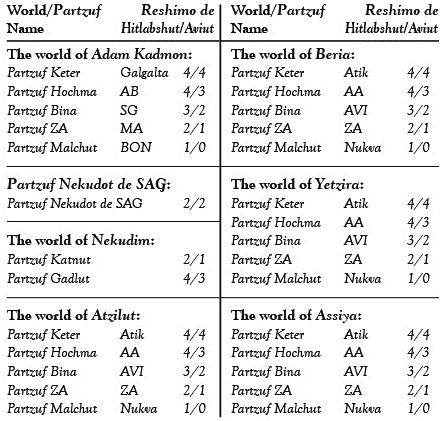Chapter 3.8 - Entrance and Exit of Lights in the Partzuf
The five parts of Malchut are called Behinot Shoresh, Aleph, Bet, Gimel, Dalet. After the restriction, when those parts receive Lights through the screen, they are called Sefirot, because the Light shines in them (Sapir means illumination in Hebrew). Therefore, from that stage on they are referred to as Sefirot:
|
Shoresh |
– |
Keter |
|
Aleph |
– |
Hochma |
|
Bet |
– |
Bina |
|
Gimel |
– |
ZA (Zeir Anpin) |
|
Dalet |
– |
Malchut |
The Reshimot (plural for Reshimo) from the Withdrawing Lights are called Otiot. Once the five Lights – Nefesh, Ruach, Neshama, Haya, Yechida – have withdrawn from the five Sefirot – Keter, Hochma, Bina, ZA, Malchut, there remain five Reshimot, or Otiot: tip of the Yod (י), Yod (י), Hey (ה), Vav (ו), Hey (ה).
Later on, we will learn how Kabbalists denote spiritual forces in writing, how they build letters, names and words from lines and dots, which is how all the holy books are written. It turns out that writing is information about spiritual acts and forces. When a Kabbalist reads books, they can perform the actions according to the instructions received from the letters.
When we read in those holy books, we think they are about past events, but the Torah specifically states: “The entire Torah is the names of the Creator.” All the words in the Torah tell us either about the vessels or their operations. This means that the entire Torah is the very same wisdom of Kabbalah we are studying now, just written in a different language.
As a rule, there are four languages: the language of the Torah, the language of the Agada (legends), that of the Talmud and the language of Kabbalah. All of them were devised by Kabbalists who attained spirituality in order to tell us how to attain the purpose of Creation.
General Outlook
The Will of the Creator is to benefit (delight) the creatures. The creatures are the ones that are meant to acquire and attain the benevolence of the Creator on their own. For that purpose, the Creator created an independent being that is completely detached from Him. The creature doesn’t feel the Creator because Light is higher than the vessel, and when it fills the vessel, it controls it and determines what the vessel will now want.
Therefore, in order to maintain its independence, the creature must be made in concealment from the Light, without feeling the presence of the Creator and spirituality. It is born in the
Such an environment would be:
A. To restrict the Light to the minimum possible, step by step. This is how the degrees were built, starting with the closest to the Creator– Ein Sof–and ending with the degree of “This World”, the farthest from the Creator. This recurrence is called “the expansion of the worlds and the Partzufim” (plural for Partzuf).
B. Once the starting point has been made ready for the creature, he must also be given a possibility to rise above that situation and attain the degree of the Creator. How can that be done? Our problem is that after the First Restriction, no Light comes to the creature, which is in the degree of “This World." Therefore, the Creator prepared a Segula (remedy) for people in this world–the Surrounding Light, which shines even into the restricted vessels.
Rabbi Yehuda Ashlag writes about this Segula in item 155 of his Introduction to the Study of the Ten Sefirot:
“Therefore we must ask: why then, did the Kabbalists obligate each person to delve in the wisdom of Kabbalah? Indeed there is a weighty thing here, worthy of being publicized: that there is a magnificent, invaluable remedy for those who delve in the wisdom of Kabbalah: that although they do not understand what they are learning, but through the yearning and the great desire to understand what they are learning, they awaken upon themselves the Lights that surround their souls.
"Meaning, everyone from Israel is guaranteed finally all these wonderful attainments that God has resolved in the Thought of Creation to grant each creature. But he who has not attained it in this life will attain it in the next and so on, until he has completed that which He preliminarily thought of. And while man has not attained perfection, these Lights that are destined to come to him, are deemed "Surrounding Lights." That means that they stand ready for him, awaiting his attainment of the vessels of reception. Then they will be dressed within the able vessels.
"Thus, even when the vessels are absent, when one delves in this wisdom, mentioning the names of the Lights and the vessels related to his soul, they immediately illuminate him to a certain degree. However, they illuminate him without dressing in the internality of his soul, since he doesn’t have the vessels needed to receive them. Indeed, the illumination one receives time and again when studying, draws upon him grace from Above, imparting him with a bounty of sanctity and purity, which greatly furthers one toward one’s perfection.”
In item 156, Rabbi Ashlag adds: “But there is a strict condition in the practice of this wisdom, that they will not materialize matters in corporeal and fictitious forms, for by that they breach the commandment, ‘Thou shalt not make unto thee a graven image, nor any manner of likeness’, for then they are harmed instead of helped.”
It follows, that only the correct study of Kabbalah can bring one to the purpose of one’s life. That is what the Kabbalists maintain, and who knows reality better?
The Surrounding Light is the Segula with which anyone can begin the ascent from this world to the spiritual world. Without this Surrounding Light, we would have no possibility of overcoming our situation. The vessel can only be corrected by means of the Light, and the Upper Light cannot descend to this world, hence the necessity for the Surrounding Light.
When Kabbalists attain spirituality, they cannot describe it in words because spirituality contains only feelings. Therefore, the books of Kabbalah are written in the Language of the Branches, when words of this world are used to discuss spiritual subjects.
The spiritual world is an abstract, "virtual" place. There are only forces and emotions there, no bodies. The spiritual terms must constantly be renewed because we cannot understand a word of what the Kabbalistic books speak of before we have an emotional connection with spirituality.
The primary mistake people make is believing that there are "Kabbalists" who teach that there is a connection between the human body and the spiritual vessel. They imply that the spiritual vessel somehow clothes the body, with each corporeal organ having a spiritual counterpart. According to that perception, if a person makes a physical gesture, any physical gesture, there is some spiritual content to it. They think that by doing so, one actually performs a spiritual act.
Their mistake stems from the fact that Kabbalists wrote their books in the language of the branches, and used corporeal words to define spiritual concepts. That is why there is such a strict prohibition in the Torah that states, “Thou shalt not make unto thee a graven image, nor any manner of likeness”. This means that it is forbidden to picture spirituality in physical images, not because it can inflict some harm on the Upper World, but because the false imaginings would stop one from understanding how the Creator works and thus interfere with the attaining of one’s goal.
Therefore, the student must repeatedly study the primary concepts in the wisdom of Kabbalah, such as Place, Time, Motion, Absence, Body, Body parts or Organs, Mating, Kiss, Embracing, etc. until every term is correctly understood.
That is what Baal HaSulam writes about in his Introduction to the Study of the Ten Sefirot. A person who wishes to study Kabbalah correctly will do well to stay away from all other books on the subject except for the Zohar, the writings of the Ari, Baal Hasulam and Rabbi Baruch Ashlag.
The interpretation of the Torah as historic episodes contradicts the statement that the entire Torah is the names of the Creator, that it is a Torah of the world of Atzilut, and that every word in it is a holy name. It is important to remember that it does not speak of this corporeal world and corporeal people.
All the names in the Torah are holy names, even names such as Pharaoh, Balaam, and Balak. The Zohar explains that each name indicates a certain spiritual degree: Pharaoh stands for Malchut, Laban stands for Partzuf Hochma, and so on.
Reshimot
In order to ensure correct action, here must be a clear understanding of what it is the vessel wants to achieve, how to achieve it, and how strong the desire is to achieve it.
There is only one creature beside the Creator, and that is the will to receive. Therefore, reality consists only of a Light and a vessel, pleasure and desire, or in Kabbalistic terms, Hitlabshut (clothing) and Aviut (thickness, coarseness).
After any spiritual act, when the Light withdraws from the vessel and the vessel becomes empty after having being filled with Light, there remain two "memories" of the previous situation:
A. Reshimo de Hitlabshut, an imprint of the Light that was present in the vessel but has now departed.
B. Reshimo de Aviut, an imprint of the vessel on the screen that remains in use.
(The prefix, de means “of” in Aramaic, thus Reshimo de Aviut means “Reminiscence of Aviut”)
These two Reshimot are considered as one Reshimo. If this Reshimo does not remain in the vessel, it will not know what to want or how to get it. The entire process of the creation of reality from its beginning in Malchut de Ein Sof to its end in this world, is a sequence of situations by means of the Light that surrounds her. It awakens the Reshimot in her, which remain after every situation she experiences.
The state where Behina Dalet is filled with Light is called Malchut de Ein Sof. After Behina Dalet feels that she is receiving, she decides to restrict the reception of the Light. The Light then withdraws, and what remains in Malchut is a Reshimo of the Light that was in her. Even after the restriction, Light continues to shine in order to fill up Malchut. But now she calculates and decides to receive only as much as she can in order to bestow to the Creator.
The data needed for the calculation is:
A. Reshimo of the clothing of the Light in the previous situation.
B. A will to receive in order to bestow.
Once Malchut makes these calculations in her Rosh (head), she then receives in the Guf (body) what she has decided to receive.
When the vessel completes the reception of that part of the Light that it decided to receive, the Surrounding Light beats on the screen and forces it to return to the Peh (mouth). The result is that the entire Partzuf is emptied of Light.
When the screen ascends from the Tabur de Galgalta to the Peh, the Inner Light exits Galgalta, leaving a Reshimo of the Light that was in there, a Reshimo de Hitlabshut. But the Reshimo from the strength of the screen that received the Light is not left, because the screen decided to stop receiving the Light, and disqualified itself from working with its own strength. Hence the Reshimo of the screen disappears.
The screen now rises from Tabur and is once more at the Peh. Because of that, it feels the Upper Light in the Rosh, which demands to be accepted. That creates in Malchut a will to receive the Light in order to bestow once more. At this point begins the birth of a new Partzuf on the Reshimot that remained from the previous situation.
Summary: A Reshimo of Light is a part of the Light that is left when the Light has withdrawn. It is the nucleus and the root for the creation of the new Partzuf. The Reshimo from the screen is then lost and a Zivug (spiritual mating) is made on a new Reshimo.
Reshimot That Create Partzufim
Reshimot from the Aviut of the Screen of the Worlds:
When the entire reality expands until there is not a single Reshimo left in the screen, it is the end of the world of Assiya.
Malchut of the world of Atzilut creates yet another Partzuf, called Adam ha Rishon (the First Man). That Partzuf was broken and divided into many parts that fell below the world of Assiya, to a place called “This World."
The smallest Reshimo in the broken vessel is called the "Point in the Heart." That is what we feel as desire for spirituality when we are awakened from Above. These Reshimot are clothed in certain individuals in our world and do not let go of them until they correct them with a screen and fill them with Light.
If a person feels this Reshimo, he is worthy of attaining spirituality, feeling the Upper World, and coming to know the actual reality. He will find the guidance to get there in the books of Kabbalah. Each generation has books that are right for the specific type of souls that descend in that generation.
The books that are intended to guide our generation into spirituality are the books of Rabbi Yehuda Ashlag (Baal HaSulam), and Rabbi Baruch Ashlag (Rabash). Besides these books, the other prerequisite that must be met for correct learning is studying in a group whose purpose is to attain the purpose of Creation, headed by a Kabbalist teacher.
The evolution of reality from Above downward created a ladder that man can climb upward. A person who reaches a certain degree discovers in it Reshimot from an even higher degree, which enable him a continued ascent up the ladder. Reshimot from higher degrees also exist in us. They are Reshimot of our own adjacent degree. By working on those Reshimot we can exit our world and enter the spiritual world.




